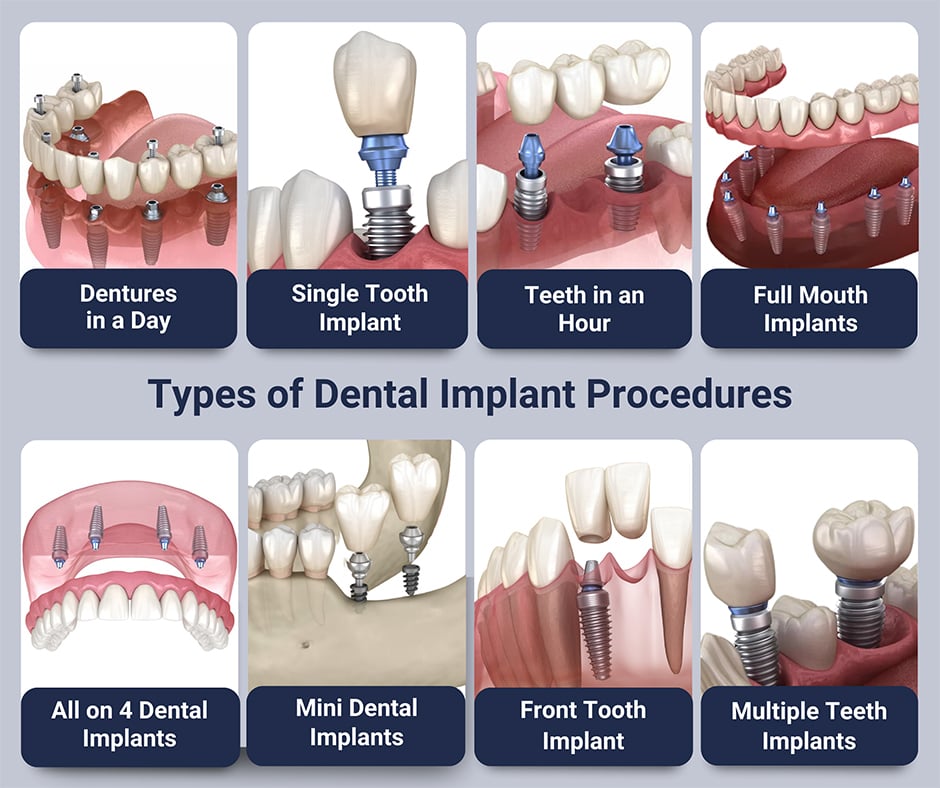Our Dental Implants PDFs
Table of ContentsAn Unbiased View of Dental ImplantsThe Single Strategy To Use For Dental ImplantsGetting The Dental Implants To WorkThe Best Strategy To Use For Dental Implants
are clinical tools operatively implanted right into the jaw to restore an individual's capability to eat or their look. They offer support for artificial (fake) teeth, such as crowns, bridges, or dentures. When a tooth is shed as a result of injury or illness, an individual can experience complications such as quick bone loss, malfunctioning speech, or changes to chewing patterns that cause discomfort.
Framework of The Oral Implant System picking dental implants, speak to your oral supplier concerning the prospective benefits and dangers, and whether you are a prospect for the procedure. Points to take into consideration: Your total wellness is a crucial consider figuring out whether you are a good candidate for oral implants, how much time it will require to heal, and how much time the implant may remain in place.
Cigarette smoking might impact the recovery process and reduce the lasting success of the implant. The healing procedure for the implant body may take a number of months or longer, throughout which time you normally have a temporary joint instead of the tooth. the dental implant procedure: Meticulously follow the dental health guidelines offered to you by your oral company.
The Best Guide To Dental Implants
Implant failing can result in the requirement for an additional surgery to deal with or change the dental implant system. Recovers the capacity to chew Restores cosmetic appearance Helps keep the jawbone from shrinking due to bone loss Preserves the health of the surrounding bone and periodontals Helps keep adjacent (nearby) teeth secure Boosts lifestyle Damages to surrounding natural teeth during dental implant positioning Injury to the surrounding cells during surgical treatment, such as sinus perforation Injury during surgery (for instance, crack of bordering jawbone) Poor feature, such as seeming like the teeth do not bite together normally An experience that the tooth is loosened or twisting in position arising from a joint screw loosening Implant body failing (looseness of the dental implant body) due to systemic infection, which may be extra most likely in clients with uncontrolled diabetes mellitus because of local infection in bone and gums sustaining the implant body as a result of delayed recovery, which may be more probable in people that smoke Difficulty cleansing the periodontals around the implant, resulting in inadequate oral health Unattended periodontal condition Post-surgical tingling due to nerve impingement or damages Always alert health and wellness care companies and imaging specialists that you have oral implants before any type of magnetic resonance imaging (MRI) or x-ray procedures.
FDA is not knowledgeable about any type of damaging events reported for MRI or x-ray treatments with dental implants. Dental implants systems are typically made from products that follow worldwide agreement standards of the International Company for Standardization (ISO) or ASTM International. These standards have details of what makes a secure product.
Other materials such as gold alloys, cobalt-based alloys, titanium alloys, or ceramic products are occasionally used. The security accounts of these products are popular. Oral dental implant systems are reviewed according reference to international consensus standards. Biocompatibility testing, to show that bodily contact with the gadget does not trigger issues like irritability or sensitive response, is component of the analysis that aids make certain the products in the oral implant system are secure and do not create damaging results when dental implanted in individuals.

The Ultimate Guide To Dental Implants
Some individuals are not qualified for oral implant surgical treatment. It is for oral cosmetic surgeons to run on people with: intense illnessuncontrollable metabolic diseasebone or soft tissue disease or Resources infectionIf these More about the author problems are fixed, a person can have the surgical treatment. Dental Implants. In, oral specialists avoid from operating people with: If people with any of the above go through oral implant surgery, there is a higher threat of the implant falling short
Some individuals have a jawbone abnormality that prevents sufficient bone for an implant from establishing. The cosmetic surgeon will then utilize a bone or bone replacement to repair and construct up the area.
Dental implant surgery is a tailored process. It's not the exact same for everyone. Yet the following provides a general overview of what you can anticipate your dental practitioner, dental specialist, periodontist or prosthodontist to do: Place the implant surgically. Offer you time to recover. Attach the message and final crown, bridge or denture.
Next, your cosmetic surgeon will very carefully put the dental implant into your jaw. If your dental implant is near the front of your mouth, your dental practitioner will certainly make a short-lived tooth for you to put on until you recover.
How Dental Implants can Save You Time, Stress, and Money.
Your company can inform you what to expect in your scenario. During the healing phase, your jawbone needs to fuse to the dental implant. This procedure, called osseointegration, is critical for security and long-term success. This procedure can take anywhere from 3 to 9 months. In many cases, it may take longer.
Once your implant heals, your dentist can connect the joint (small connector post) and your last remediation (crown, bridge or denture). This usually takes about one hour to finish and might require a second small surgical treatment. You shouldn't feel any type of discomfort throughout your oral implant treatment since your service provider will utilize medication to numb your gums.